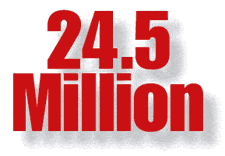 |
In this year 2004, on the outskirts of the 21st century, we are at a standoff in the war on cancer. Despite the completion of the human genome and the scientific advances in medical and radiation oncology and molecular imaging, incidence rates for all types of cancer stabilized from 1995 to 2000, following a widely heralded decline between 1992 and 1995. There was, in fact, a slight statistically significant increase in the number of deaths per 100,000 people. This is according to the latest data from the National Cancer Institute.1
The authors advised caution in reading too much into the data, because the methodology of calculating incidence rates changed since the previous tabulations. The conclusion did, however, contain what is an undeniable red flag: “as the population of older Americans increases, the number of people diagnosed with cancer is expected to double in the next several decades. Because more of these patients are living longer after a diagnosis of cancer, the strain on cancer control and health care resources to provide treatment and palliation services will increase.”1 Even if we manage to once again send the cancer incidence rates into retreat, society is in for a steep increase in the number of people with cancer. Once again, we are trumped by the demographic trick of the last century, the Baby Boomers. Their sheer numbers have threatened the solvency of Social Security, the future of Medicare, and, now, to overwhelm our health care resources.
Clearly the gauntlet is down for the medical and scientific communities, and from the triage tent in this battle, radiology has a key role to play in helping to discover new and better ways to diagnose cancer, deliver treatments, and monitor the success of those treatments. What is also becoming eminently clear is that this activity cannot take place in a vacuum, but instead requires full collaboration with the other medical specialties. After spending most of the last century cloistered in dark rooms, radiology is destined, it seems, to assume a collaborative role not only in the development of new diagnostic protocols, but also in the communication of those protocols to the medical profession.
Take the example of ACRIN 6651, which assessed the role of radiology in the pretreatment evaluation of invasive cervical cancer. Led by Hedvig Hricak, MD, PhD, chair of the Department of Radiology at Memorial Sloan-Kettering Cancer Center, New York City, the trial was overtaken by advances in medical practice and was abandoned due to the inability to recruit sufficient numbers of patients. Yet a new standard of care was established in concert with the pertinent specialties.
With change occurring so rapidly, there is no place in medicine for those who refuse to open their minds to new ideas. For radiology, the challenge is to process and manage the data our tools can provide and to initiate the requisite trials that can quickly and efficiently communicate the new standards of care to others within as well as outside the specialty, to the centers of population and to the rural outposts of America. The lesson to be drawn from ACRIN 6651 is that in collaboration, communication is as important as the discoveries that result. If we are to meet the greatest health care challenge of this century, it will be through collaborative discovery and improved communications. n
Cheryl Proval
[email protected]
References:
- Weir HK, Thun MJ, Hankey BF, et al. Annual report to the nation on the status of cancer, 1975-2000, featuring the uses of surveillance data for cancer prevention and control. J Natl Cancer Inst. 2003;95:1276-1299.




